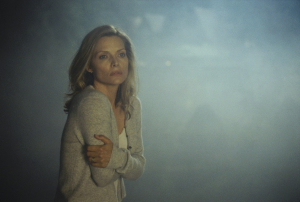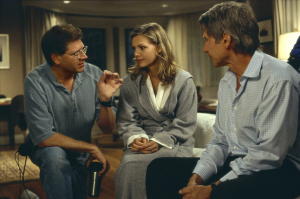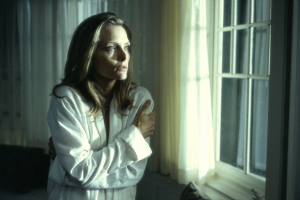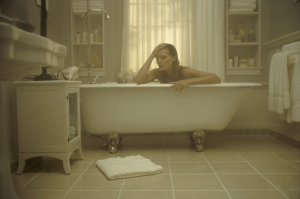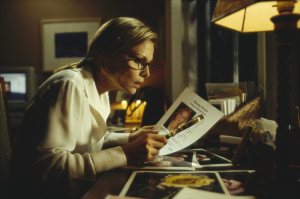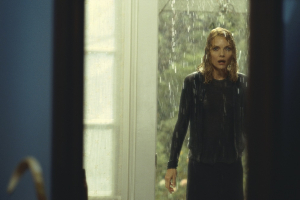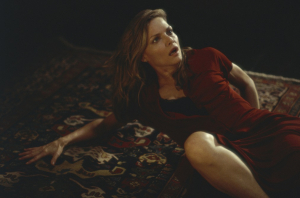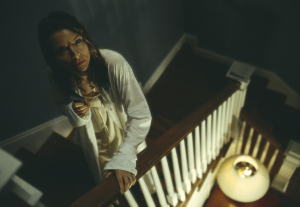What Lies Beneath
WHAT LIES BENEATH
Harrison Ford and Michelle Pfeiffer star together for the first time in a suspense-filled thriller from Oscars-winning director Robert Zemeckis (“Forrest Gump”).
It had been a year since Dr. Norman Spencer (Harrison Ford) betrayed his beautiful wife Claire (Michelle Pfeiffer). But with Claire oblivious to the truth and the affair over, Norman’s life and marriage seem perfect—so perfect that when Claire tells him of hearing mysterious voices and seeing a young woman’s wraithlike image in their home, he dismisses her mounting terror as delusion.
However, as Claire moves closer to the truth, it becomes clear that this apparition will not be dismissed, and has come back for Dr. Norman Spencer… and his beautiful wife.
Presented by DreamWorks Pictures and Twentieth Century Fox, “What Lies Beneath” is produced by Steve Starkey, Robert Zemeckis and Jack Rapke under their ImageMovers banner. The screenplay is by Clark Gregg, based on a story
by Sarah Kernochan and Gregg. Joan Bradshaw and Mark Johnson are the executive producers.
The supporting cast includes Diana Scarwid (HBO’s “Truman”), Joe Morton (“The Astronaut’s Wife”), James Remar (Gus Van Sant’s “Psycho”), Miranda Otto (“The Thin Red Line”), Wendy Crewson (“Air Force One”), Ray Baker (“Girl, Interrupted”) and supermodel Amber Valletta.
Reuniting with Zemeckis behind-the- scenes are several of his longtime collaborators, including Academy Award” – nominated director of photography Don Burgess (“Forrest Gump”), Oscar-nominated production designer Rick Carter (“Forrest Gump”), teaming with production designer Jim Teegarden, two-time Oscar -winning editor Arthur Schmidt (“Forrest Gump,” “Who Framed Roger Rabbit”) and Oscar- nominated composer Alan Silvestri (“Forrest Gump”). Working with Zemeckis for the first time are costume designer Susie DeSanto (“One Fine Day”) and Academy Award R-winning visual effects supervisor Rob Legato (“Titanic”).
ABOUT THE PRODUCTION
When director/producer Robert Zemeckis and producers Steve Starkey and Jack Rapke joined forces to create ImageMovers in 1998, one of the first questions on the table was, naturally, what kind of films they would want to produce. Zemeckis saw it as an opportunity to realize one of his filmmaking ambitions.
“During our first meetings, Bob said he was specifically looking for a film in the suspense genre,” recalls Starkey. “When DreamWorks gave us Clark Gregg’s script for ‘What Lies Beneath,’ Bob immediately wanted to move forward.”
“Bob had a very strong vision for the film from the start,” Rapke agrees. “He saw it as a pure suspense movie—perhaps the kind of film Hitchcock would have done in his day, but using the modern technology of today to help tell the story.”
Zemeckis notes, “I think suspense and cinema are really made for each other.
I mean, there are certainly very suspenseful books and stage plays, but I don’t think anything can manipulate time and place and storytelling techniques the way a movie can.
I’ve always wanted to try my hand at directing something really terrifying and mysterious.”
At the center of the mystery of “What Lies Beneath” are Norman and Claire Spencer, so the casting of these two pivotal characters was crucial to the project. “We looked at those roles and decided, in an ideal world, who our dream casting would be,” Rapke states. “Harrison Ford was Bob’s first and only choice for Norman, and we all thought Michelle Pfeiffer would be perfect for Claire. So, you know, the gods were with us, seven came up, and we got the two leads we were hoping for.”
Zemeckis adds, “Harrison brings a kind of ‘Rock of Gibraltar’ strength to the screen. To me, he’s the definition of absolute stardom.
And Michelle is truly gifted. She’s completely believable as this vulnerable woman, and at the same time conveys great inner strength.
Along with her acting ability, she brings incredible beauty and a powerful screen presence to the role. You can’t take your eyes off her.”
While honoring the secrecy regarding much of the plot and his role, Harrison Ford does reveal that a number of different things drew him to the project and to the part of Dr. Norman Spencer. “Ordinarily, I respond to a character and his dilemma. In this case, I responded to the idea of the film itself.
It was so immediate, so contemporary. I loved the construction of the script and the surprises built into it, as well as the character.
I really can’t say anything more about him.. .but I think that’s what makes a good thriller; you don’t want to take the fun out of it by knowing how it all ends.”
Though limited in what she can disclose about her own role of Claire Spencer, Michelle Pfeiffer does offer, “Claire was a musician, but she had put all the passion that once went into her music into her daughter Caitlin. When Caitlin leaves for college, it’s like the rug has been pulled out from under Claire. She starts hearing whispering voices and seeing things that might be unexplainable, but then again,
could be explained—strange things that could be her imagination, or the wind, or the house settling.. .or a presence in the house. But I think however convinced you might be that there’s a presence in your house, you’d try to explain it away in any way you could because the alternative is so frightening. After all, Claire is married to a scientist who doesn’t believe in ghosts, so for a time she begins to doubt her own sanity.”
Pfeiffer continues, “I’ve loved scary movies since I was a kid, but as an actress the genre was new territory for me, which is exactly what I was looking for. I am also a huge fan of Bob Zemeckis and had always wanted to work with him. He has this sort of childlike enthusiasm about moviemaking that is very infectious, so even though the filming was incredibly hard work, he made it fun.”
Her appreciation for the director is shared by Ford, who offers, “Bob is a spectacular film craftsman and a very skilled storyteller. He is so good that he is able to take a film beyond its genre distinctions, as I think he did with this film. Also, the way he shot it made a real impression on me. He used complicated camera moves, allowing for really long takes, which gave his actors a chance to develop a scene in a more organic way.”
Surrounding Ford and Pfeiffer is an ensemble of actors, who each play a pivotal role in the story. Diana Scarwid is Jody, Claire’s best friend and confidante, who might know more about the truth of what’s happening than even she realizes; Joe Morton plays Dr. Drayton, Claire’s psychiatrist, who may or may not believe her; and James Remar and Miranda Otto are Mr. and Mrs. Feur, the mysterious couple next door who first arouse Claire’s suspicions. Rounding out the supporting cast are Wendy Crewson, Ray Baker, Micole Mercurio, Amber Valletta,
Katherine Towne and Sloane Shelton.
Principal photography on “What Lies Beneath” began in the late summer of 1999 in Addison, Vermont, a picturesque location on the banks of Lake Champlain in Vermont’s Daughters of the American Revolution State Park. Screenwriter Clark Gregg had specified a New England setting for the story, noting,
“While I never specifically named it, I had always envisioned the Spencers in a place like Burlington, Vermont, which is an academic community where I spent many summers with my theater company. The region felt like a natural fit for someone like Norman to have grown up in and to now be pursuing his life’s work, so I was thrilled when Steve Starkey told me they had found a location near Burlington that seemed perfect.”
“We scouted a number of locations in New England to find a location that was adaptable to the different story points of the film, water being one of them. The location overlooking Lake Champlain was perfect,” says Starkey.
“Filming in a state park was ideal because it gave us absolute control over the entire area in terms of logistics, as well as security.”
The location might have been perfect, but it was lacking one major element that was integral to the story: the Spencers’ house, which is the center of the paranormal activity in the story. Production designers Rick Carter and Jim Teegarden collaborated with Bob Zemeckis in the design of the 3,500 square-foot Nantucket-style shingled house, which was constructed from the ground up on the lakeshore. They also designed and built the Feurs’ house next door, as well as the wooden dock leading from the Spencer house to the water.
Once the Vermont home was complete, Carter and Teegarden duplicated both the
exterior and interior of the house in their entirety on soundstages in Los Angeles, which provided a controlled environment for shooting night scenes, as well as flexibility for the action and visual effects. Teegarden explains, “The Vermont location house was built as a real two-story house and had to be structurally sound. The crew had to make accommodations to shoot around things there, because if we’d made it so you could pull everything out, the house would have collapsed. By contrast, the stage house in Los Angeles was almost completely adaptable,
with removable walls and multiples of certain rooms where more action takes place. For instance, there were five versions of the bathroom set alone.”
Carter remarks, “The Spencer house has to appear first as a seemingly perfect home for the perfect couple, but as the story progresses it evolves into something more sinister. Jim and I spent a long time working out every detail. For example, we used a specific shade of blue on the interior that, with the right light, can appear very nice and bright, but takes on another feeling as things become darker and more threatening.”
The production design themes were in concert with those of costume designer Susie DeSanto. “That was something Rick Carter and I always talked about—moving from light into darkness and back into the light towards the end of the film,” says DeSanto. “You see that especially reflected in Claire’s wardrobe, where I used a lot of white and then moved more into grays and black.”
Another key design element established by Carter and Teegarden in the house was the use of mirrors. Carter offers, “We used mirrors as a kind of gateway to the truth, so there are a lot of mirrors throughout the house. But the only time you should be really aware of them is when they’re reflecting something wrong.”
Multiple mirrors may have been important to the mystery of “What Lies Beneath,” but, as any director of photography can attest, they can create a challenging environment in which to film without revealing cameras and equipment. To help work around them, as well as to maneuver through some of the tighter sets, cinematographer Don Burgess utilized a long crane arm that could extend from about four feet to eighteen feet long with a camera attached on the end.
Zemeckis and Burgess also applied camera angles which begin at eye level and progressively move lower and lower as the fear intensifies.
The bi-coastal, non-sequential shooting schedule posed another major challenge for the director of photography. “We shot the film totally out of sequence, sometimes even filming different parts of the same scene at different times and on opposite coasts, which would ordinarily be a continuity nightmare,”
Burgess reveals.
In overcoming the challenge, Burgess employed the Panavision Kodak Digital Photography system. During filming, a camera assistant would shoot digital stills of a scene and then download the stills into a computer with software that could simulate the actual film stock Burgess had chosen for the film. The camera crew could then print out a representation of what the shot was going to look like, so it could be matched later. Computer technology played an even larger role in the visual effects of “What Lies Beneath.” However, Starkey notes, “The effects in a Zemeckis film are really storytelling techniques. He likes to take advantage of the latest technology to tell the story in unique ways. It’s like he invents his own film grammar through the use of special effects.”
Visual effects supervisor Rob Legato agrees, stating, “I’ve always felt that visual effects should be built into the fabric of the movie, and as such should enhance the story, not draw you out of it. And in a film like this, my job is to make the effects even more seamless than in, say, a science fiction film. They should almost breeze by, and you’d never know that I had a hand in the film at all.”
Zemeckis offers, “In approaching this film, I told Rob to try to imagine what Alfred Hitchcock would have done if he’d lived in the digital age and had access to computer graphics. What might he have done? We had a ball experimenting with different types of effects, but I’m hoping that 90 percent of them are invisible.”
Filming on “What Lies Beneath” extended from the late summer into the autumn months in New England. The change of seasons worked perfectly for the style of the film, as the bright days of summer gave way to the deepening shadows and darker colors of the fall.
Zemeckis comments, “When you see the house in the sunlight it looks like the perfect dream home. But then you start to make the shadows long and drop the camera to a lower angle, and the house is suddenly ominous and . Everything in the movie had to
work on two layers. Depending on how you look at something, it can be beautiful or an instrument of terror, which is one of the great devices for a scary movie.”
Starkey adds, “I think one of the things that makes a good thriller is that on the surface, you start out believing that everything is as it seems or can be easily explained away, but then you start peeling away those layers, and if it’s cleverly done, it just keeps you guessing.”
“Audiences today are very hip and savvy to the conventions of the genre, so you have to go beyond them,” Zemeckis notes. “You can’t do what the masters like Hitchcock were able to do, because the audience would be 20 minutes ahead of the plot. That’s the greatest challenge, because I think the enjoyment of movies like this comes from not knowing what to expect.”
